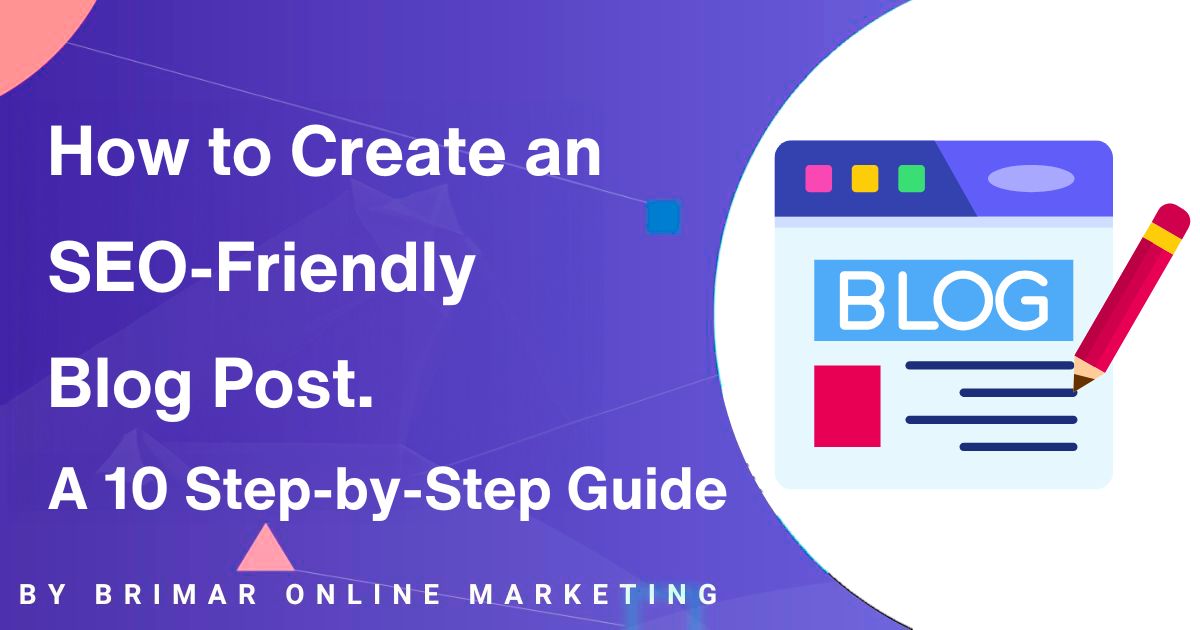
If you want more people to find your blog, SEO isn’t something you can ignore.
The right approach can push your content to the top of search engine results, bringing in organic traffic without spending a dime on ads.
But writing an SEO-friendly blog post isn’t just about throwing in a bunch of keywords and hoping for the best.
Search engines reward high-quality content that’s relevant, well-structured, and genuinely helpful.
When you create content that meets search intent and provides a valuable resource for readers, it’s a win-win, your audience gets helpful information, and your website climbs the rankings.
Whether you’re a small business owner, a content creator, or a digital marketer, mastering search engine optimization can give you a serious edge.
This guide will walk you through each step, helping you write content that connects with your target audience and gets noticed by search engines.
Step 1: Choose the Right Blog Topic and Target Keyword
The first step in creating an SEO-friendly post is deciding what to write about.
Your blog topic needs to be something your target audience cares about.
If people aren’t searching for it, it won’t matter how well you optimize it, no one will find it.
A good blog post starts with strong keyword research.
Tools like Google Keyword Planner and other keyword research tools help you find the right keywords with high search volume.
But picking a focus keyword isn’t enough.
You also need to consider long-tail keywords and related keywords that match user intent.
These give your content a better chance of ranking by targeting specific searches instead of competing for overly broad terms.
The best way to use keywords is naturally.
Search engines are intelligent; they can tell when you’re keyword stuffing, but won’t reward it.
Instead, strategically place your main keyword in your blog title, meta description, subheadings, and throughout your post naturally.
You’re already setting yourself up for success when you pick the right topic and structure your content around relevant keywords.
The next step?
Writing a post that keeps readers engaged while meeting SEO best practices.
Start Attracting Customers Through SEO Today!
We can help you attract new customers through Tailored Search Engine Optimization Strategies for Your Business.
Step 2: Craft a Compelling Blog Title and Title Tag
A great blog post starts with a title that grabs attention.
The proper title makes readers want to click while also helping search engines understand what your content is about.
To boost visibility, your focus keyword should fit naturally within the title without making it sound forced.
Think about what would make someone stop scrolling and click.
The best titles spark curiosity, offer solutions, or highlight a key benefit.
Numbers, power words, and emotional triggers often work well.
Best Practices for Blog Titles:
- Keep it under 60 characters to avoid being cut off in search results.
- Make it clear, engaging, and relevant to your audience’s pain points.
- Use words that encourage action, like “How to,” “Best,” “Ultimate Guide,” or “Secrets.”
Now, let’s talk about the title tag, the short text that appears in search results.
While similar to the blog title, you can tweak it slightly to make it even more compelling.
A good title tag improves click-through rates and helps your content stand out in search results.
Best Practices for Title Tags:
- Include your main keyword
- Keep it concise and to the point.
- Make it unique. Avoid duplicate titles across your site.
The correct title and title tag can mean the difference between getting clicks or ignoring.
Give them the attention they deserve.
Step 3: Write an Engaging Meta Description

Once your title catches readers’ eye, the meta description convinces them to click.
This short snippet appears under the title in search results, acting like a mini-ad for your content.
A well-written meta description boosts your content rank and increases click-through rates.
What Makes a Good Meta Description?
- Keep it under 160 characters to ensure it displays correctly in search results.
- Naturally include your main keyword, but don’t overdo it.
- Give readers a reason to click by offering value or solving a problem.
Here’s an easy way to think about it: If someone found your blog in a Google search, what would make them choose your post over others?
Instead of just summarizing, make it compelling.
A good meta description teases what’s inside while clarifying why clicking is worth it.
For example, instead of:
“This blog post discusses SEO tips for beginners.”
Try:
“Struggling to get traffic? Learn the best SEO tips to boost rankings and drive more visitors to your site.”
The goal isn’t just to describe; it’s to attract.
Write your meta description with the same care as your title, and you’ll have a better chance of getting clicks from search results.
Step 4: Structure Your Blog Content for Readability
A blog post that’s easy to read keeps visitors engaged, increases time on page, and makes it easier for search engines to understand your content.
No one enjoys reading a massive block of text.
Breaking it up into digestible sections improves the user experience and keeps readers returning.
Here’s how to make your blog content more readable:
- Use subheadings: They act as signposts, guiding readers (and search engines) through your content. Clear, descriptive subheadings also help with search engine rankings.
- Write short paragraphs: Long paragraphs can feel overwhelming. Stick to 2-3 sentences per paragraph for easy readability.
- Use bullet points and numbered lists: They highlight key points and make scanning the content effortless.
- Include internal links: Linking to other pages on your site helps visitors find relevant information while improving search engine rankings. It also signals to search engines that your site is well-structured.
- Add external links to authoritative sources. This will give your content credibility and provide extra value to readers. Google considers well-referenced content more reliable.
- Make it mobile-friendly: Many internet users browse on mobile devices. You’re losing potential traffic if your post isn’t easy to read on a phone.
A well-structured blog post isn’t just about SEO optimization; it’s about ensuring your audience finds the information they need without frustration.
Step 5: Optimize Your Content with Relevant Keywords
Keywords help your blog appear in search results, but stuffing them into every sentence won’t do you any favors.
Search engines have evolved, and they prioritize high-quality content that sounds natural.
Here’s the best way to use keywords effectively:
- Place your main keyword strategically: It should appear in your blog title, introduction, subheadings, and conclusion. This indicates to search engines what your content represents about.
- Use long-tail and related keywords: These help capture a wider audience by matching different variations of a search query.
- Keep it natural: Stuffing your content with keywords makes it unreadable and can hurt your search engine rankings. Use them where they fit naturally.
Search engines reward well-written, SEO-friendly content that genuinely helps readers.
Instead of forcing keywords, write relevant content that answers your audience’s questions.
That’s how you create an SEO-optimized blog post that ranks and gets results.
Step 6: Enhance Your Blog Post with Visual Elements

A wall of text isn’t exactly inviting.
Readers skim before they commit, and adding the right visuals can make all the difference.
Images, infographics, and videos break up long sections, making your content easier to digest.
They also help explain complex ideas in a way that words alone can’t.
But here’s the catch: search engines don’t “see” images like we do.
That’s where alt text comes in.
Adding a short, descriptive tag to each image not only improves accessibility for visually impaired users but also helps search engines understand what your content is about.
A well-optimized image can even appear in Google Search results, bringing in more visitors.
Page speed is another factor you can’t ignore.
Large, uncompressed images slow down your site, frustrating visitors and pushing them to leave.
The fix?
Compress your images before uploading and use the right file formats (JPEG for photos, PNG for transparent graphics, and WebP for a balance of quality and speed).
A faster site means a better user experience and a higher chance of ranking well.
If you want to keep readers engaged, adding videos, GIFs, and infographics is a great way to make your content more dynamic.
Whether it’s a short tutorial or an eye-catching stat breakdown, visual elements keep people on the page longer, something search engines love.
Step 7: Improve Internal Linking and External Linking
Think of your blog as a roadmap.
Readers land on your post, but where do they go next?
That’s where internal links come in.
By linking to other pages on your website, you can direct visitors to more helpful content and keep them engaged longer.
This improves user experience and tells search engines that your site is well-structured and full of valuable information.
The trick is to make internal links feel natural.
Instead of forcing them into your post, use them where they truly add value.
If you’ve mentioned a topic you’ve already covered in another post, that’s the perfect spot to drop a link.
Over time, internal linking helps build a strong content network, making it easier for search engines to crawl and index your site.
On the other hand, outbound links (links to external websites) add credibility.
When you reference statistics, studies, or expert opinions, linking to reputable sources shows that your content is well-researched.
It’s a signal to search engines that your post isn’t just fluff, it’s backed by solid information.
A good balance of internal and external links strengthens your blog’s authority, improves search engine rankings, and keeps your readers engaged.
Plus, linking to high-quality external sources can even help you build relationships with other sites in your industry.
Who knows?
They might return the favor with a link to your content, further boosting your organic traffic.
Step 8: Write High-Quality and In-Depth Content
If you want your blog to rank well and keep readers returning, you must write something that is worth their time.
Great content isn’t just about throwing words on a page; it’s about creating something valuable, informative, and engaging.
Readers (and search engines) reward content that answers real questions, provides valuable insights, and keeps readers engaged.
Think about what people are searching for.
What problems do they need solved?
What questions pop up when they type a search query into Google?
If your content clearly and thoroughly addresses those needs, you have a much better chance of ranking higher in search results.
Detailed and lengthier posts usually yield better results.
Aim for at least 1,500 to 2,100 words to give your content enough depth while staying focused on the topic.
But don’t write long just for the sake of it; make sure every section serves a purpose.
If something doesn’t add value, cut it.
SEO is essential, but user experience matters even more.
Write in a way that’s easy to read, using clear subheadings, bullet points, and short paragraphs.
Keep things conversational, like you’re explaining something to a friend.
If your content is genuinely helpful, readers will stay longer, share it, and return for more, which signals to search engines that your post deserves a top spot.
Step 9: Promote Your Blog Post on Social Media

Hitting “publish” is just the beginning.
If you want people to see your blog post, you need to get it in front of them, and social media is one of the best ways to do that.
Start by sharing your post on platforms where your audience hangs out.
Whether that’s Facebook, Instagram, LinkedIn, or X, the key is not just to post a link and disappear.
Write a short, engaging caption that makes people want to click.
Ask a question, highlight an interesting point, or tease a key takeaway.
Engagement goes both ways.
If people comment, reply.
If they share your post, thank them.
The more interaction your content gets, the more likely it is to reach a wider audience.
Repurposing your content is another great way to get more eyes on your post.
You can turn key points into bite-sized social media posts, create an infographic, or film a quick video summarizing the main takeaways.
If you have an email list, send your subscribers a short teaser and a link to read the full post.
The more places your content appears, the more chances it has to attract clicks, shares, and new readers.
And the best part?
Every share and mention signals to search engines that your post is relevant, giving it a better shot at ranking higher in search results.
Step 10: Monitor Performance and Make Improvements
Publishing a blog post is just the beginning.
You need to track how it performs to keep your content ranking well and drive traffic.
Use analytics tools to monitor search engine rankings, click-through rates, and engagement.
These insights help you understand what’s working and what needs tweaking.
If a post isn’t performing as expected, don’t let it sit there collecting dust, optimize it.
Small updates can lead to significant improvements.
Refresh outdated information, improve readability, and add internal links to keep readers exploring your site.
Check your search engine results to see if new search intent trends have emerged and adjust your content accordingly.
SEO is never “set and forget.”
The best way to stay relevant is to revisit your posts regularly and ensure they continue to provide valuable content that meets reader expectations.
Final Thoughts
Writing an SEO-friendly blog post isn’t about stuffing in as many keywords as possible; it’s about creating content that ranks well and keeps readers engaged.
Every step, from keyword research to structuring your post and optimizing for readability, makes sure your blog gets noticed.
Follow these best practices, and your content will have a better chance of appearing in search results, attracting more readers, and boosting your website’s visibility.
Above all, content quality matters.
The rankings and traffic will follow if your blog delivers relevant, well-structured, and engaging content that aligns with search intent.
Keep refining your approach, and you’ll build a blog that stands the test of time.
Our SEO Services Have Helped Our Clients Increase Their Revenue!
“I highly recommend Brimar if your looking to grow your online business. You will be satisfied with the high level of expertise and high quality of services. It has helped my business grow by leaps and bounds.”
CEO

